OPEL MERIVA 2009 Owners Manual
Manufacturer: OPEL, Model Year: 2009, Model line: MERIVA, Model: OPEL MERIVA 2009Pages: 248, PDF Size: 4.46 MB
Page 131 of 248
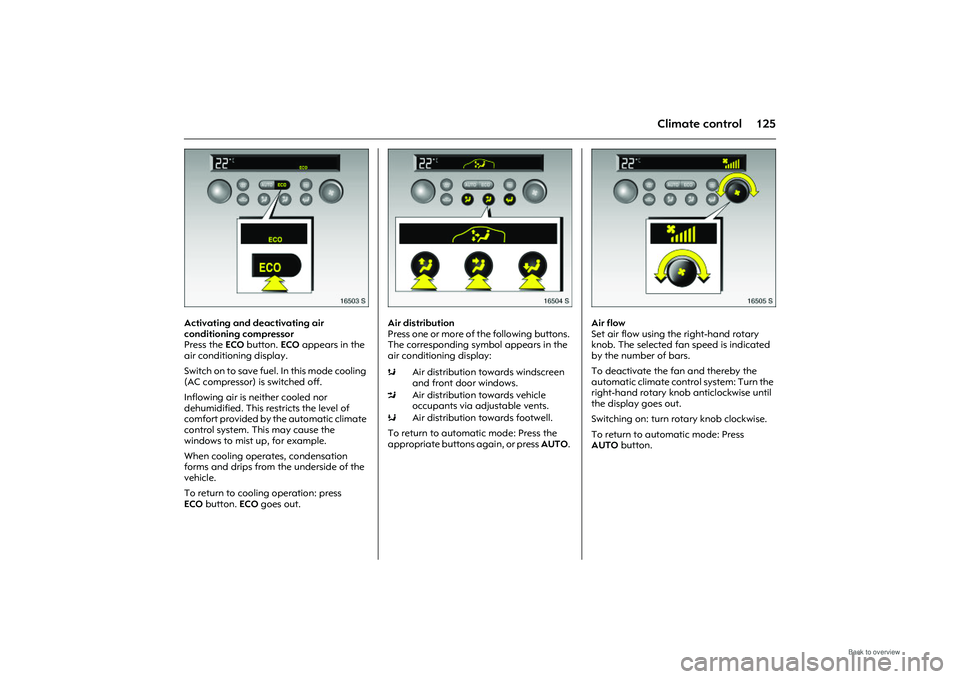
125
Climate control
Picture no: 16503s.tif
Activating and deactivating air
conditioning compressor
Press the ECO button. ECO appears in the
air conditioning display.
Switch on to sa ve fuel. In this m ode cooling
(AC compressor) is switched off.
Inflowing air is neither cooled nor
dehumidified. This restricts the level of
comfort provided by the automatic climate
control system. This may cause the
windows to mist up, for example.
When cooling operates, condensation
forms and drips from the underside of the
vehicle.
To return to cooling operation: press
ECO button. ECO goes out.
Picture no: 16504s.tif
Air distribution
Press one or more of the following buttons.
The corresponding symbol appears in the
air conditioning display:
To return to automatic mode: Press the
appropriate buttons again, or press AUTO.
Picture no: 16505s.tif
Air flow
Set air flow using the right-hand rotary
knob. The selected fan speed is indicated
by the number of bars.
To deactivate the fan and thereby the
automatic climate control system: Turn the
right-hand rotary knob anticlockwise until
the display goes out.
Switching on: turn rota ry knob clockwise.
To return to automatic mode: Press
AUTO button.
sAir distribution towards windscreen
and front door windows.
M Air distribution towards vehicle
occupants via adjustable vents.
K Air distribution towards footwell.
Page 132 of 248
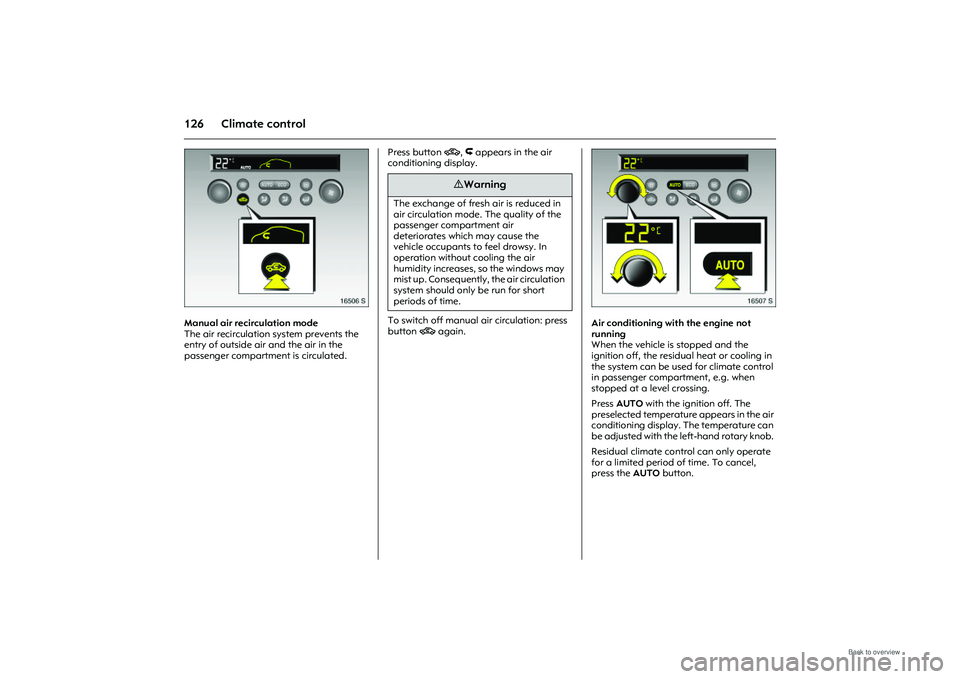
126 Climate control
Picture no: 16506s.tif
Manual air recirculation mode
The air recirculation system prevents the
entry of outside air and the air in the
passenger compartment is circulated. Press button
4, % appears in the air
conditioning display.
To switch off manual air circulation: press
button 4 again.
Picture no: 16507s.tif
Air conditioning with the engine not
running
When the vehicle is stopped and the
ignition off, the residu al heat or cooling in
the system can be used for climate control
in passenger compartment, e.g. when
stopped at a level crossing.
Press AUTO with the ignition off. The
preselected temperature appears in the air
conditioning display. The temperature can
be adjusted with the left-hand rotary knob.
Residual climate control can only operate
for a limited period of time. To cancel,
press the AUTO button.
9 Warning
The exchange of fresh air is reduced in
air circulation mode. The quality of the
passenger compartment air
deteriorates which may cause the
vehicle occupants to feel drowsy. In
operation without cooling the air
humidity increases, so the windows may
mist up. Consequently, the air circulation
system should only be run for short
periods of time.
Page 133 of 248
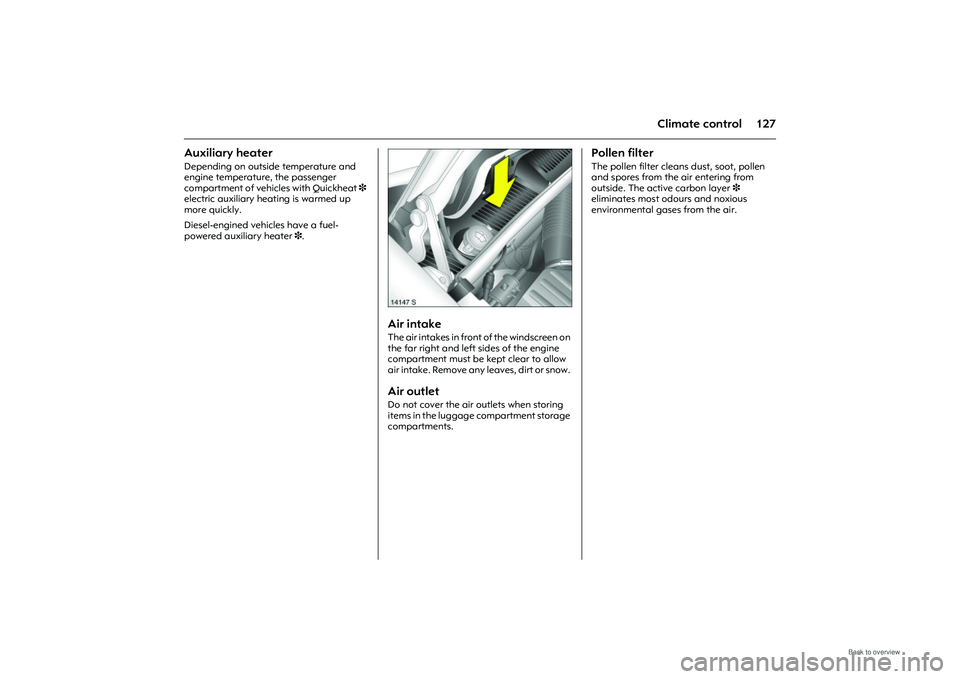
127
Climate control
Auxiliary heater Depending on outside temperature and
engine temperature, the passenger
compartment of vehicles with Quickheat 3
electric auxiliary heating is warmed up
more quickly.
Diesel-engined vehicles have a fuel-
powered auxiliary heater 3.
Picture no: 14147s.tif
Air intake The air intakes in front of the windscreen on
the far right and left sides of the engine
compartment must be kept clear to allow
air intake. Remove any leaves, dirt or snow. Air outletDo not cover the air outlets when storing
items in the luggage compartment storage
compartments.
Pollen filter The pollen filter cleans dust, soot, pollen
and spores from the air entering from
outside. The active carbon layer 3
eliminates most odours and noxious
environmental gases from the air.
Page 134 of 248
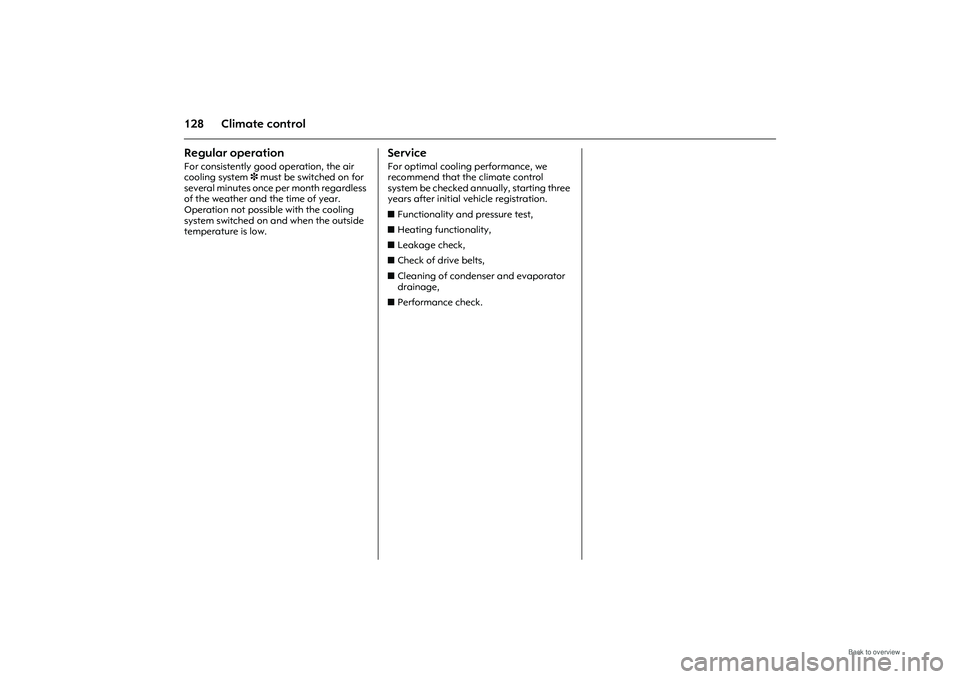
128 Climate controlRegular operationFor consistently good operation, the air
cooling system 3 must be switched on for
several minutes once per month regardless
of the weather and the time of year.
Operation not possible with the cooling
system switched on and when the outside
temperature is low.
Service For optimal cooling performance, we
recommend that the climate control
system be checked annually, starting three
years after initial vehicle registration.
z Functionality and pressure test,
z Heating functionality,
z Leakage check,
z Check of drive belts,
z Cleaning of condenser and evaporator
drainage,
z Performance check.
Page 135 of 248
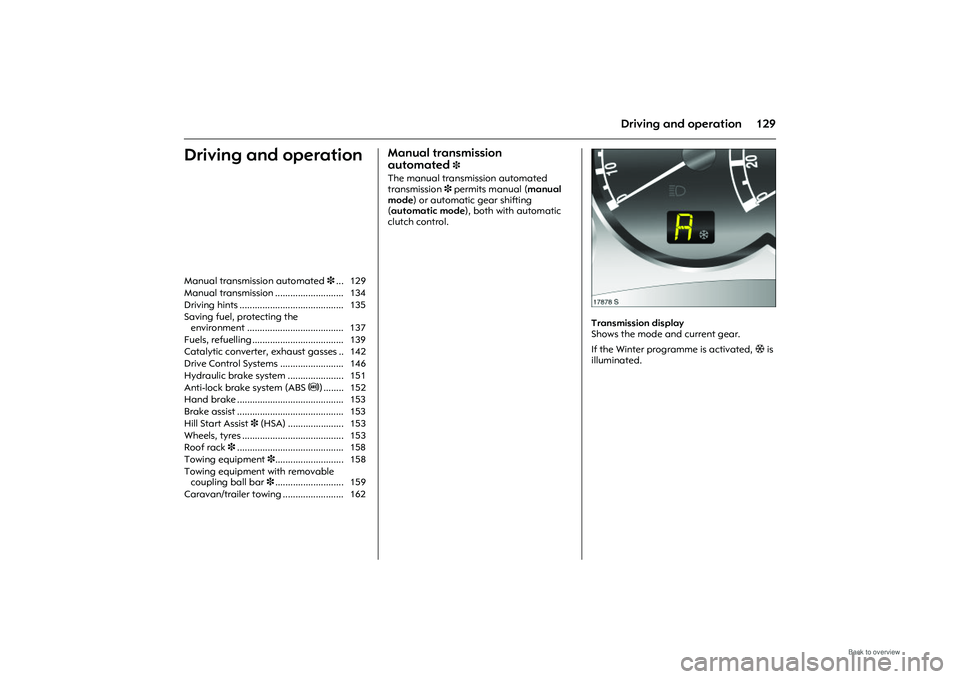
129
Driving and operation
Driving and operation
Manual transmission
automated
3
The manual transmission automated
transmission 3 permits manual ( manual
mode ) or automatic gear shifting
(automatic mode ), both with automatic
clutch control.
Picture no: 17878s.tif
Transmission display
Shows the mode and current gear.
If the Winter programme is activated, T is
illuminated.
Manual transmission automated
3... 129
Manual transmission ........................... 134
Driving hints ......................................... 135
Saving fuel, protecting the environment ...................................... 137
Fuels, refuelling .................................... 139
Catalytic converter, exhaust gasses .. 142
Drive Control Systems ......................... 146
Hydraulic brake system ...................... 151
Anti-lock brake system (ABS u ) ........ 152
Hand brake .......................................... 153
Brake assist .......................................... 153
Hill Start Assist 3 (HSA) ...................... 153
Wheels, tyres ........................................ 153
Roof rack 3.......................................... 158
Towing equipment 3........................... 158
Towing equipment with removable coupling ball bar 3........................... 159
Caravan/trailer towing ........................ 162
Page 136 of 248
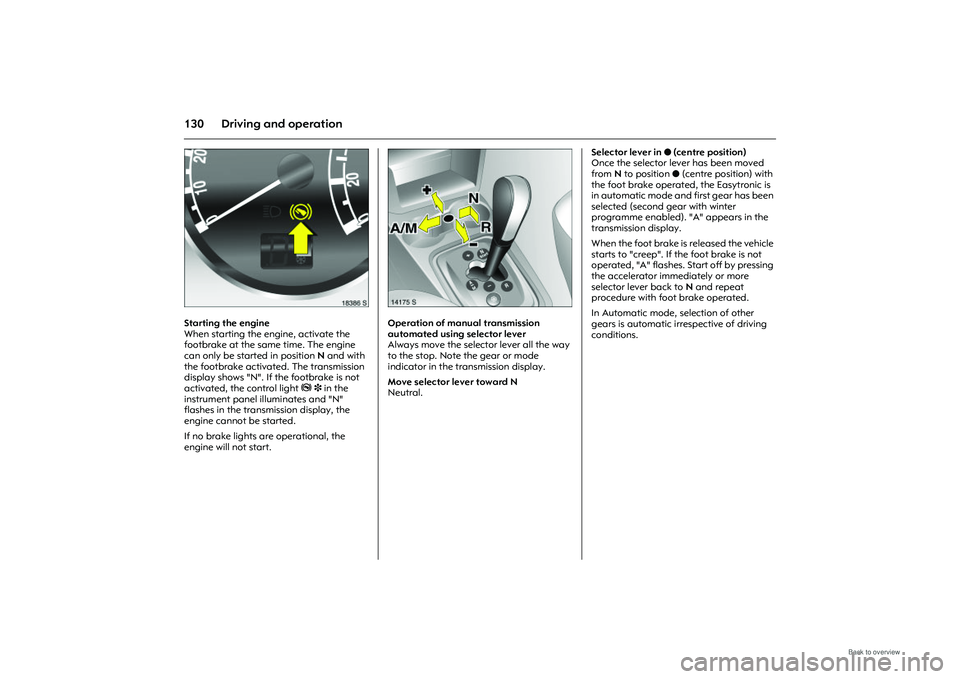
130 Driving and operation
Picture no: 18386s.tif
Starting the engine
When starting the engine, activate the
footbrake at the same time. The engine
can only be started in position N and with
the footbrake activated. The transmission
display shows "N". If the footbrake is not
activated, the control light j 3 in the
instrument panel illuminates and "N"
flashes in the transmission display, the
engine cannot be started.
If no brake lights are operational, the
engine will not start.
Picture no: 14175s.tif
Operation of manual transmission
automated using selector lever
Always move the selector lever all the way
to the stop. Note the gear or mode
indicator in the transmission display.
Move selector lever toward N
Neutral. Selector lever in
o (centre position)
Once the selector lever has been moved
from N to position o (centre position) with
the foot brake operated, the Easytronic is
in automatic mode and first gear has been
selected (second gear with winter
programme enabled). "A" appears in the
transmission display.
When the foot brake is released the vehicle
starts to "creep". If the foot brake is not
operated, "A" flashes. Start off by pressing
the accelerator immediately or more
selector lever back to N and repeat
procedure with foot brake operated.
In Automatic mode, selection of other
gears is automatic irrespective of driving
conditions.
Page 137 of 248
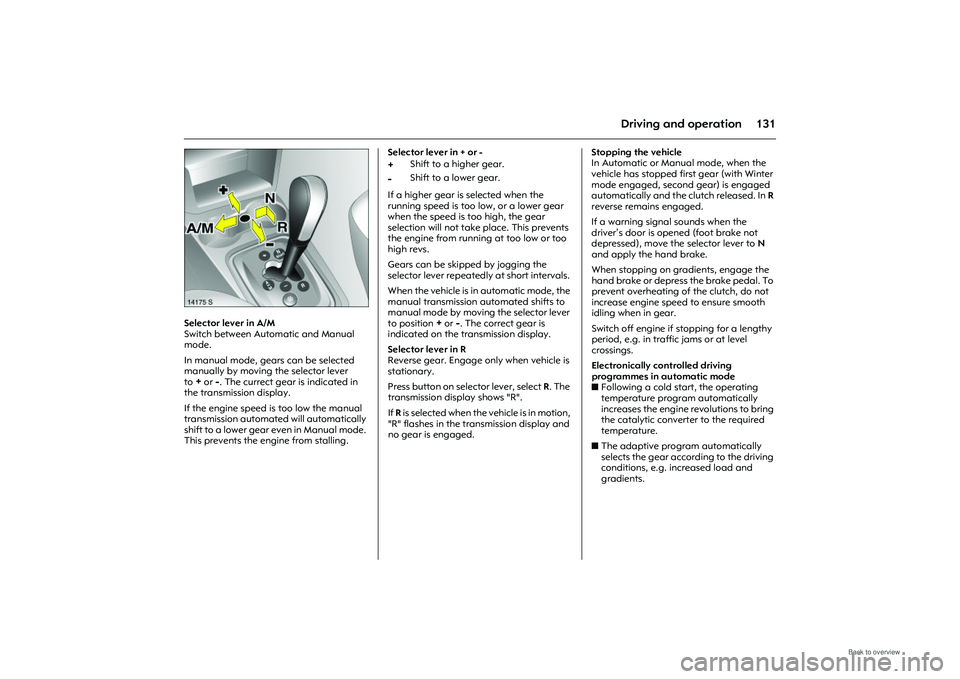
131
Driving and operation
Picture no: 14175s.tif
Selector lever in A/M
Switch between Automatic and Manual
mode.
In manual mode, gears can be selected
manually by moving the selector lever
to
+or
-. The currect gear is indicated in
the transmission display.
If the engine speed is too low the manual
transmission automated will automatically
shift to a lower gear even in Manual mode.
This prevents the engine from stalling. Selector lever in + or -
If a higher gear is selected when the
running speed is too low, or a lower gear
when the speed is too high, the gear
selection will not take place. This prevents
the engine from running at too low or too
high revs.
Gears can be skipped by jogging the
selector lever repeatedly
at short intervals.
When the vehicle is in automatic mode, the
manual transmission automated shifts to
manual mode by moving the selector lever
to position
+ or
-. The correct gear is
indicated on the transmission display.
Selector lever in R
Reverse gear. Engage only when vehicle is
stationary.
Press button on selector lever, select R. The
transmission display shows "R".
If R is selected when the vehicle is in motion,
"R" flashes in the transmission display and
no gear is engaged. Stopping the vehicle
In Automatic or Manual mode, when the
vehicle has stopped first gear (with Winter
mode engaged, second gear) is engaged
automatically and the
clutch released. In R
reverse remains engaged.
If a warning signal sounds when the
driver’s door is opened (foot brake not
depressed), move the selector lever to N
and apply the hand brake.
When stopping on gradients, engage the
hand brake or depress the brake pedal. To
prevent overheating of the clutch, do not
increase engine speed to ensure smooth
idling when in gear.
Switch off engine if stopping for a lengthy
period, e.g. in traffic jams or at level
crossings.
Electronically controlled driving
programmes in automatic mode
z Following a cold start, the operating
temperature program automatically
increases the engine revolutions to bring
the catalytic converter to the required
temperature.
z The adaptive program automatically
selects the gear according to the driving
conditions, e.g. increased load and
gradients.
+
Shift to a higher gear.
-
Shift to a lower gear.
Page 138 of 248
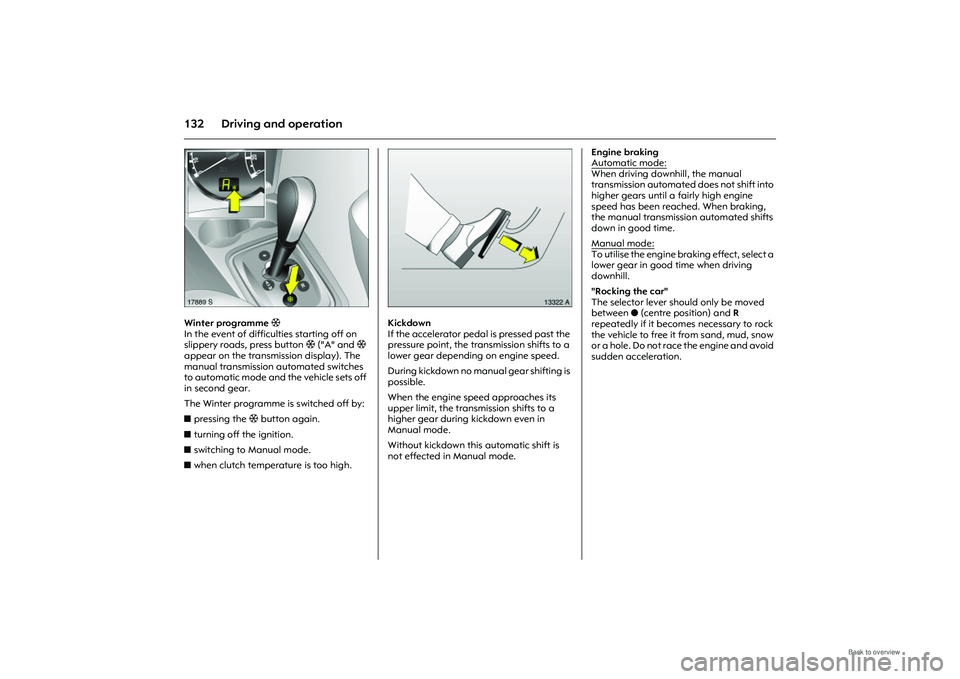
132 Driving and operation
Picture no: 17889s.tif
Winter programme T
In the event of difficulties starting off on
slippery roads, press button T ("A" and T
appear on the transmission display). The
manual transmission automated switches
to automatic mode and the vehicle sets off
in second gear.
The Winter programme is switched off by:
z pressing the T button again.
z turning off the ignition.
z switching to Manual mode.
z when clutch temperature is too high.
Picture no: 13322a.tif
Kickdown
If the accelerator pedal is pressed past the
pressure point, the transmission shifts to a
lower gear depending on engine speed.
During kickdown no manual gear shifting is
possible.
When the engine speed approaches its
upper limit, the transmission shifts to a
higher gear during kickdown even in
Manual mode.
Without kickdown this automatic shift is
not effected in Manual mode. Engine braking
Automatic mode:
When driving downhill, the manual
transmission automated does not shift into
higher gears until a fairly high engine
speed has been reached. When braking,
the manual transmission automated shifts
down in good time.
Manual mode:To utilise the engine br
aking effect, select a
lower gear in good time when driving
downhill.
"Rocking the car"
The selector lever should only be moved
between o (centre position) and R
repeatedly if it beco mes necessary to rock
the vehicle to free it from sand, mud, snow
or a hole. Do not race the engine and avoid
sudden acceleration.
Page 139 of 248
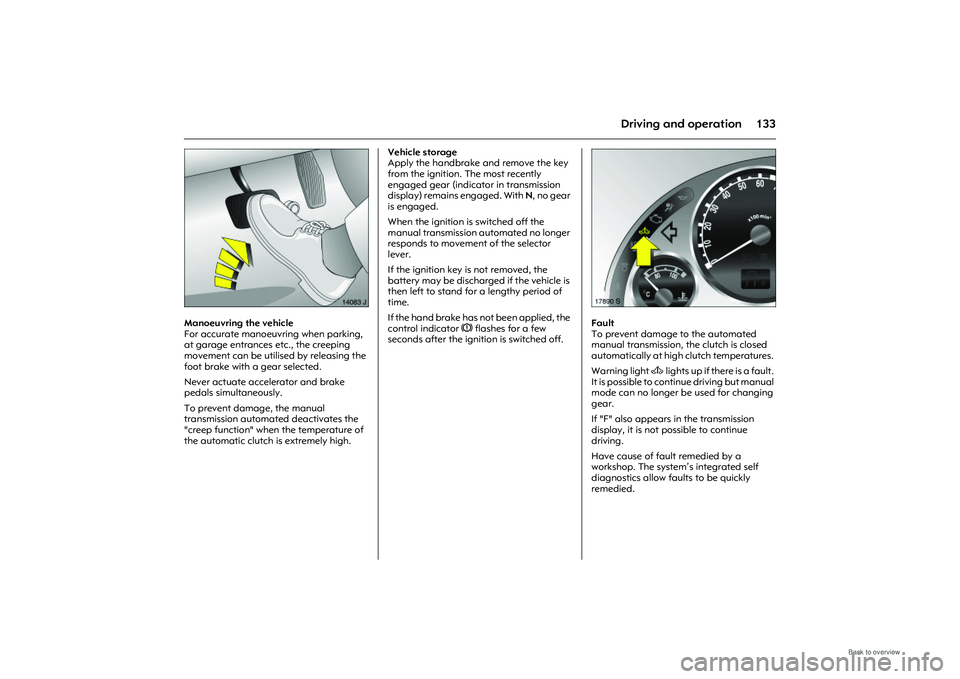
133
Driving and operation
Picture no: 14083j.tif
Manoeuvring the vehicle
For accurate manoeuvring when parking,
at garage entrances etc., the creeping
movement can be utilised by releasing the
foot brake with a gear selected.
Never actuate accelerator and brake
pedals simultaneously.
To prevent damage, the manual
transmission automated deactivates the
"creep function" when the temperature of
the automatic clutch is extremely high. Vehicle storage
Apply the handbrake and remove the key
from the ignition. The most recently
engaged gear (indicator in transmission
display) remains engaged. With
N, no gear
is engaged.
When the ignition is switched off the
manual transmission automated no longer
responds to movement of the selector
lever.
If the ignition key is not removed, the
battery may be discharg ed if the vehicle is
then left to stand for a lengthy period of
time.
If the hand brake has not been applied, the
control indicator R flashes for a few
seconds after the ignition is switched off.
Picture no: 17890s.tif
Fault
To prevent damage to the automated
manual transmission, the clutch is closed
automatically at high clutch temperatures.
Warning light A lights up if there is a fault.
It is possible to continue driving but manual
mode can no longer be used for changing
gear.
If "F" also appears in the transmission
display, it is not possible to continue
driving.
Have cause of fault remedied by a
workshop. The system’s integrated self
diagnostics allow faults to be quickly
remedied.
Page 140 of 248
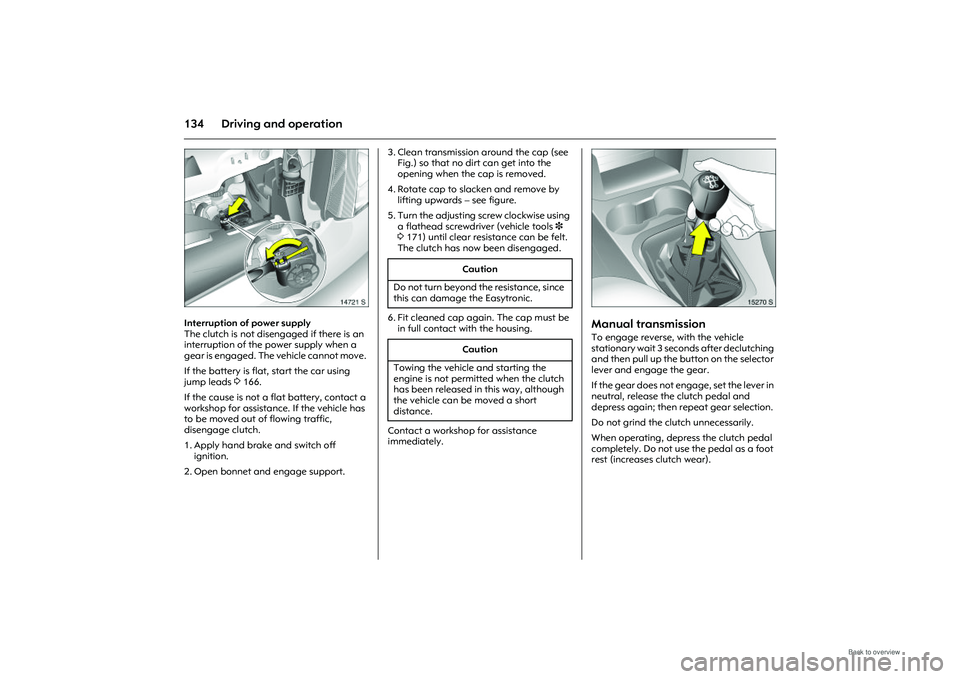
134 Driving and operation
Picture no: 14721s.tif
Interruption of power supply
The clutch is not disengaged if there is an
interruption of the power supply when a
gear is engaged. The vehicle cannot move.
If the battery is flat, start the car using
jump leads 3166.
If the cause is not a flat battery, contact a
workshop for assistance. If the vehicle has
to be moved out of flowing traffic,
disengage clutch.
1. Apply hand brake and switch off ignition.
2. Open bonnet and engage support. 3. Clean transmission around the cap (see
Fig.) so that no dirt can get into the
opening when the cap is removed.
4. Rotate cap to slacken and remove by lifting upwards – see figure.
5. Turn the adjusting screw clockwise using a flathead screwdriver (vehicle tools 3
3 171) until clear resistance can be felt.
The clutch has now been disengaged.
6. Fit cleaned cap again. The cap must be in full contact with the housing.
Contact a workshop for assistance
immediately.
Picture no: 15270s.tif
Manual transmissionTo engage reverse, with the vehicle
stationary wait 3 seconds after declutching
and then pull up the bu tton on the selector
lever and engage the gear.
If the gear does not engage, set the lever in
neutral, release the clutch pedal and
depress again; then re peat gear selection.
Do not grind the clutch unnecessarily.
When operating, depress the clutch pedal
completely. Do not use the pedal as a foot
rest (increases clutch wear).
Caution
Do not turn beyond the resistance, since
this can damage the Easytronic.
Caution
Towing the vehicle and starting the
engine is not permitted when the clutch
has been released in this way, although
the vehicle can be moved a short
distance.